

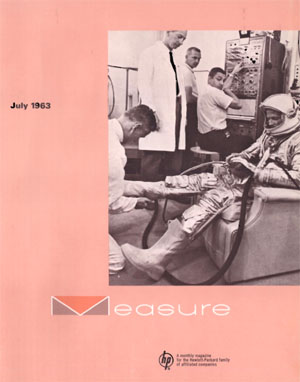 |
Cover of the first issue of MEASURE Magazine - July 1963 Courtesy of Hewlett-Packard Company |
The first issue of MEASURE magazine was published July 1, 1963. Dave Packard writes in this first issue:
"The goal of MEASURE is to serve as a regular, effective medium of communication among all our people. The primary objective of MEASURE is to inform. But we also want the magazine to be interesting and entertaining. We want it to be the type of publication that you will take home and share with your family and friends."
Measure Magazine was edited monthly up to the Company split in 1999.
Most of the MEASURE Magazine issues published between 1963 and 1999 have been scanned by Glenn Robb and are available as PDF files on his hparchive web site. As a contribution to this great work, we are working on the building of an index with subject category classification to give fast and accurate access to this huge amount of data about the history of the Hewlett Packard Company.
On October 14, the IEEE Standards Coordinating Committee 14 on Quantities and Units adopted the name 'hertz' for the unit of frequency. This name had earlier been adopted by the National Bureau of Standards and before that by the International Committee on Weights and Measures and by the International Electrotechnical Commission. IEEE Committee adoption of 'hertz' applies to the publication of technical and scientific data.
In adopting 'hertz' the IEEE Committee observed that 'hertz' is preferred because of the widespread use of 'cycle' alone as a unit of frequency. 'Cycle per second' is, of course, technically correct, but the use of 'cycle' in place of 'cycle per second' is declared incorrect.
IEEE adoption of 'hertz' came about as part of the Committee 14 adoption of the International System (SI) of units for the IEEE. These units were earlier adopted by the International Committee on Weights and Measures and were printed in the March, 1964, issue of the 'Hewlett-Packard Journal."
Another aspect of the recommended practice adopted by the IEEE Committee is that the use of British-American units is deprecated. The recommendation states that the 'number of British-American units in use should be reduced as rapidly as possible.' The SI System incorporates the metric system.
In the June, 1965, issue, the 'Hewlett-Packard Journal' indicated that it would increasingly adopt 'hertz.' That term is used in this issue and will be generally used in the future.
Catalog publication was not yet annual during the sixties.
The general catalogs published during the 60s were the following: 1960, 1961, 1963, 1965, 1967, 1968 and 1969. Photos of their respective cover are shown below.
| Cover of the 1960 decade catalogs available in the collection |
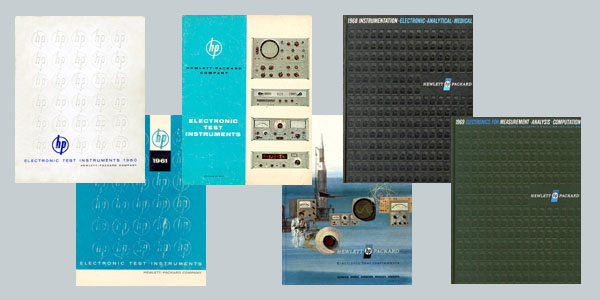 |
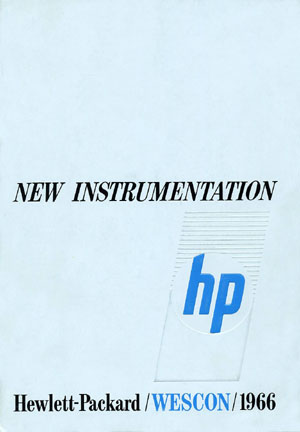 |
Cover of the 1966 Hewlett Packard short-form catalog |
The Hewlett Packard General Catalog wouldn't become a yearly systematic publication until 1975. By the way, during the 60s there would be a lot of short-form catalogues edited to fill the gaps between the years without an edition of the general catalog.
General catalog published during the 60s were the following: 1960, 1961, 1963, 1965, 1967, 1968 and 1969. Photos of their respective cover are shown on the picture above.
Among the many short-form catalogs edited during the 60s one example is the special edition made for the Hewlett Packard WESCON 1966. Reproduction of its full 14 page contents can be seen here:
1966 Shot-Form Catalog. ( PDF, 3.6 Mo)
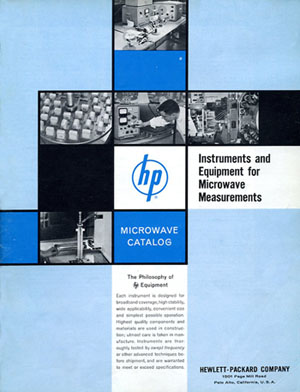 |
Cover of the 1961 Microwave Catalog Courtesy of the Hewlett-Packard Company |
Probably one of the very first Product-line-dedicated catalogs is this 1961 MICROWAVE CATALOG. Its contents recap all the instruments and accessories available for the measurement of waveguide and coaxial systems by the beginning of the 60s.
Almost every product listed in this catalog is easy to find today at a very low cost on the surplus market. All these devices can still be used today in a broad range of applications to help in the education and in the understanding of the basis of microwave physics.
Another useful characteristic of this catalog is the method of classification chosen which is that products are classified by their usable frequency range. A number of selection tables give an immediate overview of the various accessories available for each type of measurement, in each type of waveguide and inside its usable passband.
Model numbers of HP waveguide components are normally preceded by a prefix letter, which designates the waveguide size and frequency band of the instrument. The table below, scanned from the microwave catalog, is a chart of standard waveguide specifications for these bands.
1961 Microwave Catalog ( PDF, 11.3 Mo )
| Chart of Standard Waveguide Specifications for Band S to Band R |
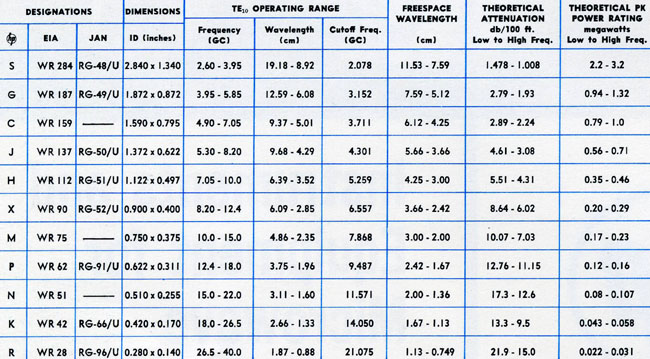 |
Another tool for customer information was the dedicated newspaper, which appeared during the 1960s. It was another way to fill-in the long time period between the yearly general catalog editions and was also a commercial aid for the sales forces.
| Cover of the July/August 1967 edition of Measurement News Courtesy of the Hewlett-Packard Company |
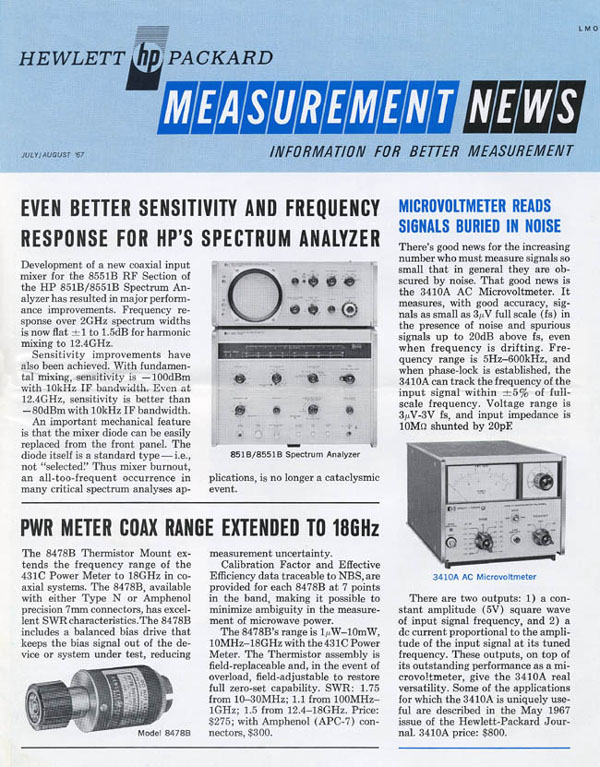 |
| Back Cover of the July/August 1967 edition of Measurement News Courtesy of the Hewlett-Packard Company |
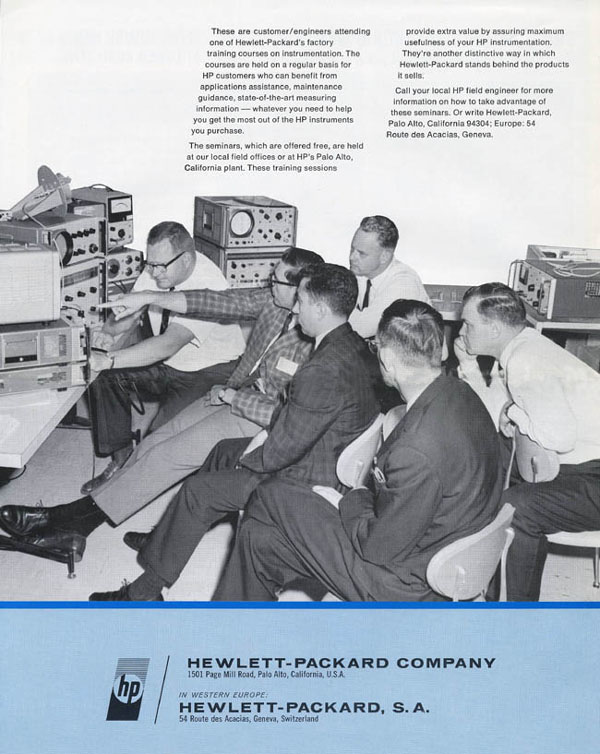 |
Publication of Application Notes, sporadic at the beginning, would grow very quickly in the sixties with the multiplication of instruments and product lines.
A complete listing of the original Application Notes available in the HP Memory Project collection can be found here . Some of these documents are scanned and downloadable as PDF files. Since the launch of this web site we have had many demands to add application notes, which were not already scanned and which are very difficult to find as original documents today. On receiving such demands, we always try to answer your requests as soon as possible but requests must be done using the Contact Us Form with a significant label entered in the "Subject" text field.
By the end of the 60s, slide rules were the only calculation help found in labs. The most widespread one was the basic slide rule, used for arithmetic, trigonometric and logarithmic calculations. Frequently found in scientific laboratories, were specialized slide rules dedicated to particular calculations. Among them, Hewlett Packard slide rules were largely diffused in electronic laboratories. These products were not for sale, they were gifts and were sometimes given directly to the customer by the salesman during a visit. Sometimes the gift was inserted in a document sent to the customer. For example, a Pulsed RF Calculator was included in the Application Note 150-2 which was dedicated to Spectrum Analysis Pulsed RF Measurements. Needless to say, these small gifts were very useful to the engineer's work at this time, highly appreciated by the customers and a great sales-aid for the HP field engineer. Another HP Way of doing "Contributive Business."
Click in the selected slide rule to start its Javascript Simulator